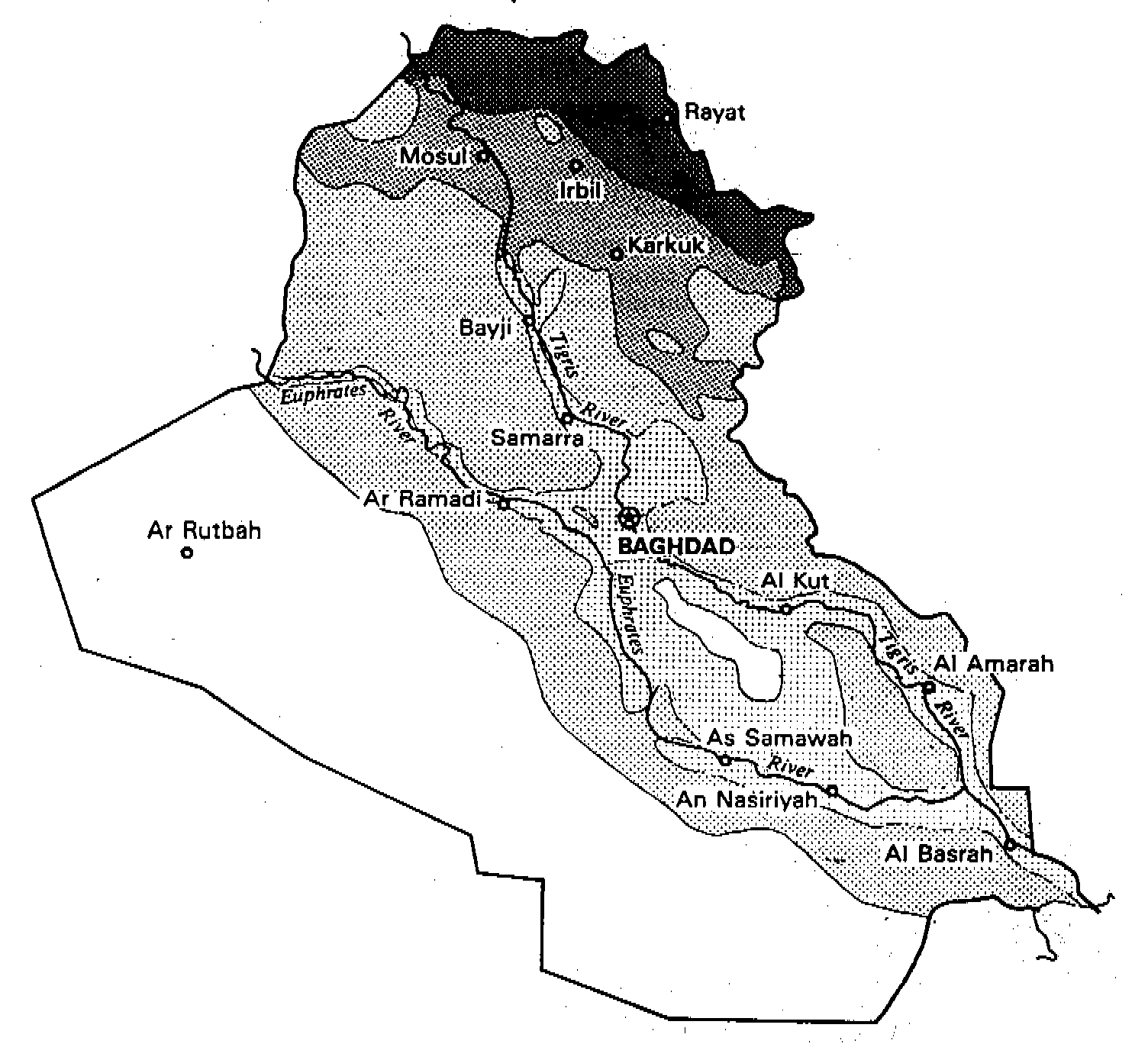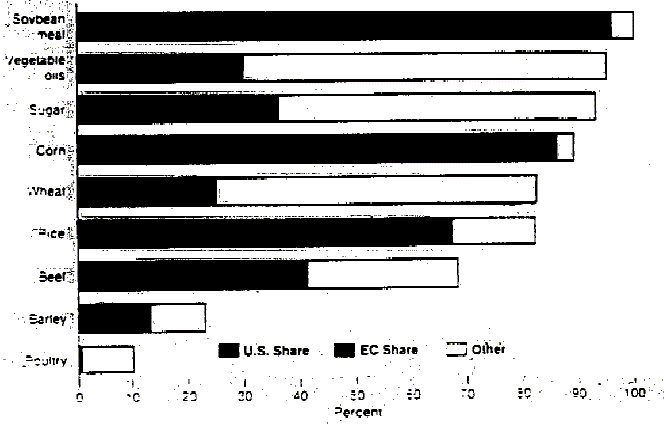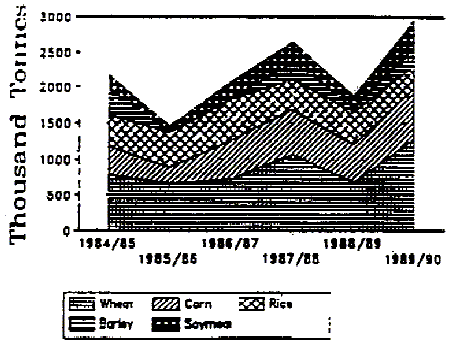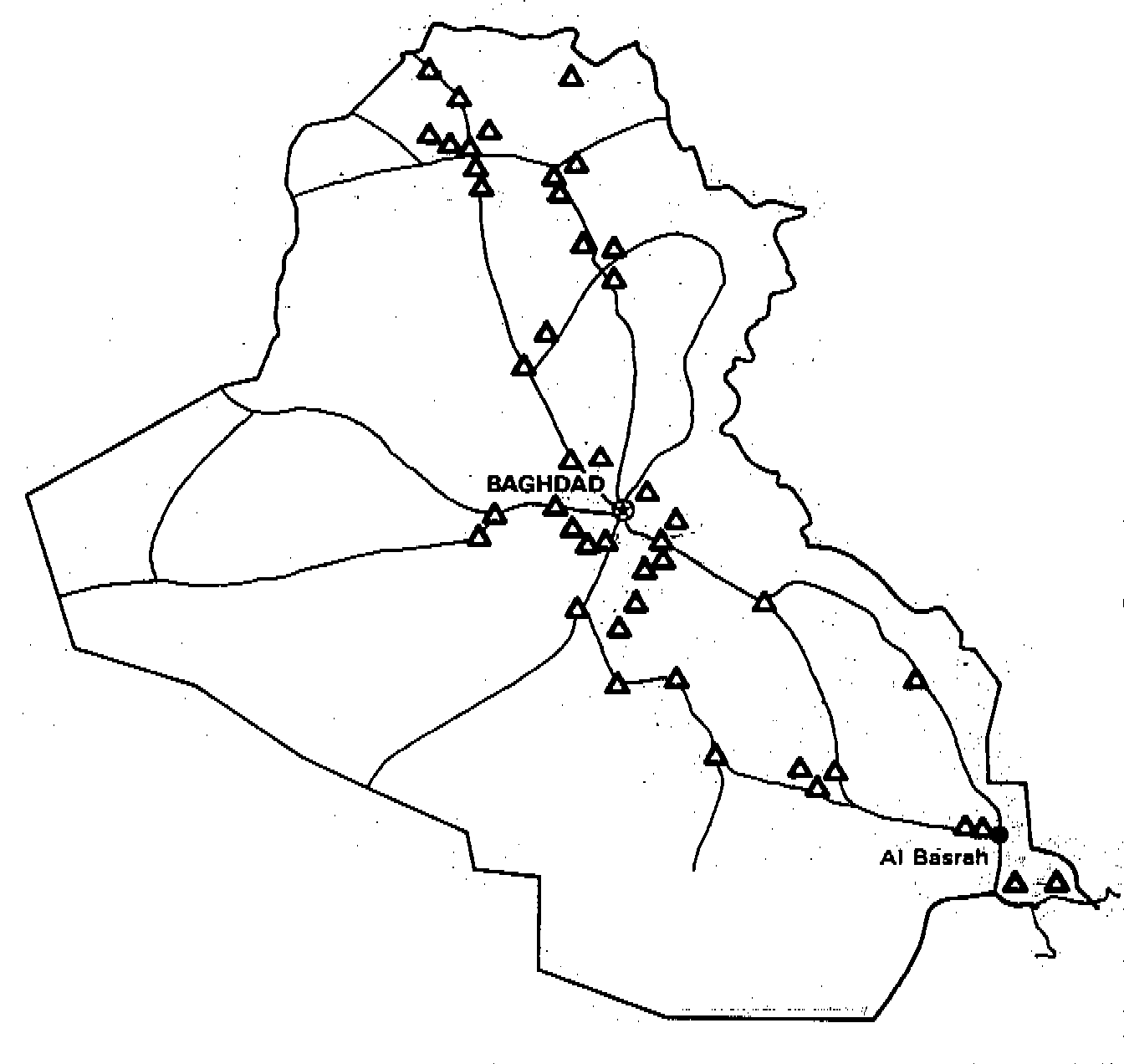
The US Library of Congress maintains a Congressional Research Service which produces briefings for Congress. As this 1991 briefing is, to CASI's knowledge, unavailable on the web, we have created this HTML version. The format has been altered in conversion so this should not be considered an original document (15 July 2000).
|
|

| Congressional Research Service · Library of Congress |
Prior to the August 1990 U.N. embargo, about 75 percent of the total calories consumed in Iraq were imported. By mid-January. 1991 when the war began, and 5 months after the embargo was imposed, stocks of many foods important to the Iraqi diet were in short supply. Evidence, either in rationing activities or high prices, indicated severe shortages of vegetable oil, sugar, tea, milk, eggs, and wheat. Early in the bombing campaign, the loss of electricity in many urban areas of Iraq caused the loss of perishable foods, such as frozen meat and refrigerated produce.
This year's grain harvest in May-June is extremely important to Iraq, Last fall, Saddam Hussein mandated an 80 percent increase in area planted; if rainfall is adequate, then the harvest could be double what it was in 1990. If the rainfall is deficient, the harvest still could be 50 percent to 80 percent above last year's level of .8 million metric tons.
The limited availability of fuel and the damage done by the bombing to the Iraqi infrastructure could seriously hamper harvesting, processing and distributing the crop. So, while the yield could be ample in the fields, the people now seem likely to face serious food needs this year due to logistical problems.
In recent years, the United States was the largest supplier of agricultural goods, providing between one-fourth and one-third of Iraq's imported agricultural needs. Other major suppliers were the European Community, Turkey, Australia, and Canada.
Virtually all U.S: agricultural goods shipped to Iraq through July 1990 were under U.S. Government programs, such as the export credit guarantee programs (GSM-102 and GSM-103) and the Export subsidy program called the Export Enhancement Program (EEP). Iraq was the 12th largest market for U.S. agricultural exports in 1989. Iraq was the second largest recipient of the U.S. Government-guaranteed export loans and the seventh largest EEP subsidy recipient during the latter half of the 1980s.
Currently, the U.S. Government is monitoring the refugee situation in the countries surrounding Iraq and has donated commodities for refugee humanitarian needs. U.S. officials are currently studying and considering food assistance to Iraq and Kuwait after the war.
| page in original | ||
| 1 | Iraq's Major Agricultural Areas | 4 |
| 2 | Iraq Depends Heavily on Imported Food | 5 |
| 3 | Iraq Imports from the U.S. | 8 |
| 4 | Iraq's Grain Storage Warehouse Management Units | 11 |
| page in original | ||
| 1 | Planting and Harvesting Schedule in Iraq | 3 |
| 2 | Iraq Agricultural Imports from Specified Suppliers | 6 |
| 3 | Quantity of Selected U.S. Agricultural Exports to Iraq | 7 |
On August 2, 1990 Iraq invaded and militarily occupied Kuwait. In response to this action President Bush, under authority of the International Emergency Economic Powers Act (IEWA), imposed U.S. economic sanctions and called for a worldwide embargo on trade with Iraq. The United Nations Security Council subsequently supported President Bush's actions by passing UN Resolution 661 which imposed a complete and worldwide embargo, with the exception of food and medical supplies for humanitarian purposes.
During the months preceding the war, the embargo prohibited virtually all trade with Iraq in both directions, including food and agricultural commodity imports, as well as oil exports. Although this action drastically reduced food stocks and foreign exchange earnings with which to purchase food or other imports, Bush administration officials testified before Congress in December 1990 that the sanctions appeared to be ineffective in removing Iraqi forces from Kuwait.
Since the beginning of the coalition air war campaign on January 16, 1991, the food situation in Iraq and Kuwait has continued to deteriorate. Current food stocks are thought to be at record lows in both countries but, without external assistance, will have to support the population until the next grain harvest in May and June 1991. Embargo leakages from Iran, Jordan, Syria or Turkey were dramatically reduced with the bombing of bridges and roadways.
Additionally, allied bombing of refineries, fuel reserves, roads and bridges (and, loss of electricity that supported flour mills and perishable food storage facilities) will seriously hamper food availability and distribution in both countries. The May-June wheat and barley harvest in Iraq will be difficut with both a shortage of manpower due to the draft and a lack of fuel to power the farm machinery. Even if a plentiful crop is harvested, getting the food into a useable form and getting it to the population (traditionally by truck) will be seriously impaired.
Import capability and infrastructure damage is also a key concern for Kuwait, which was dependant on imports for virtually all of its food supply. After the war, the lack of infrastructure may seriously impede food aid activities in Iraq and Kuwait, as well.
Following are some of, the most frequently asked questions regarding the status of Iraq and Kuwait's food and agricultural, situation during and after the war.
Prior to the embargo in August 1990, about 40 percent or the calories in a typical Iraqi diet came from bread; about 30 percent from rice, cooking oil and sugar; about 13 percent came from fruits and vegetables; and the remaining calories came from meat, dairy, and eggs. U.S. Government sources currently are estimating that by March 1991 the daily Iraqi caloric intake could be less than half of what it was prior to the embargo.
Iraq is self-sufficient in the production of dates and vegetables, such as potatoes, squash, onions, tomatoes, broadbeans, chickpeas, lentils, and dry beans. In recent years, Iraq exported significant quantities of dates, fruit juices, and vegetables which, because of the embargo, cannot be exported, but can be used for domestic consumption.
Although Iraq imports a large amount of grains, it does produce significant quantities of wheat, barley, some corn, and rice, Most of Iraqi meat consumption has been of poultry meat. Iraq produces some livestock - poultry, cattle, sheep and goats - and conducts fish farming, particularly around Basrah in the southeastern region of the country. Table 1 provides a schedule for Iraq's planting and harvesting of key commodities and figure 1 illustrates where the growing areas in Iraq are.
| Commodity | Planting season | Harvesting season |
| Grains | ||
| wheat | November to mid-December | May to mid-June |
| barley | October to mid-December | mid-April to mid-May |
| rice | mid-April to May | mid-Sept. to mid-Oct. |
| corn | June | September to mid-Oct. |
| Vegetables | ||
| broadbeans | mid-December to January | May |
| dry beans | August | October to November |
| chickpeas | mid-Dec. to mid-Jan | end of May |
| lentils | October to November | mid-April to May |
| onions | September | May |
| peas | September | November |
| potatoes | ||
| - spring | February | June |
| - fall | August | December |
| tomatoes | February to March | May to July |
| Fruits | ||
| apples | --- | June to September |
| dates | --- | September to October |
| oranges | --- | December to March |
| grapes | --- | June to November |
Source: Planting and Harvesting Seasons for Africa and West Asia, FAS-M-90, July 1960.
Figure 1: Iraq: Major Agricultural Areas

 Primary rain-fed cultivated lands (wheat, barley)
Primary rain-fed cultivated lands (wheat, barley)
 Fruits, vegetables, rice, barley
Fruits, vegetables, rice, barley
 Woodland and grazing, cultivation in valleys
Woodland and grazing, cultivation in valleys
 Desert grazing and marginal agriculture
Desert grazing and marginal agriculture
 Desert and semidesert
Desert and semidesert
Source: Central Intelligence Agency, January 1991.
Prior to the embargo, about 75 percent of the total calories consumed in Iraq were imported. Iraq imported 100 percent of its soybean meal, 95 percent of its vegetable oil, more than 93 percent of its sugar, nearly 90 percent of its corn, about 82 percent of its wheat, 82 percent of its rice, 68 percent of its beef, 24 percent of its barley and 10 percent of its poultry. (See figure 2.)
Figure 2: Iraq Depends Heavily on Imported Food

Average share of consumption provided by imports 1987 - 89
Source: Agricultural Outlook, Iraq Faces Embargo, by John Parker, Michael
Kurtzig, and Tom Bickerton, Economic Research Service, USDA, September, 1990.
Prior to the embargo, Kuwait imported as much as 96 percent of its total caloric needs. Kuwait's primary food imports from all sources consisted of many high valued products including (in order of value) live animals, vegetables, fruits, and nuts, dairy products and eggs, as well as cereals. In past years Kuwait has produced feed grains, such as corn, barley and oats, as well as some dairy and livestock products.
In recent years, the United States was the largest supplier. of imported agricultural goods to Iraq. In 1988 and 1989, for example, the United States provided 32 percent and 26 percent, respectively, of Iraqi imported agricultural supplies (on a monetary value basis). Other major foreign agricultural suppliers to Iraq included the European Community, Australia, Canada, and Turkey. (See Table 2.)
| Supplier | 1985 | 1986 | 1987 | 1988 | 1989 |
| (million dollars) | |||||
| United States | 320 | 360 | 532 | 808 | 749 |
| EC | 332 | 193 | 215 | 334 | 398 |
| Turkey | 239 | 148 | 209 | 356 | 355 |
| Australia | 167 | 121 | 178 | 300 | 340 |
| Canada* | 42 | 79 | 95 | 160 | 209 |
| Other | 1,041 | 1,156 | 1,156 | 687 | 988 |
| Total | 2,099 | 1,978 | 2,290 | 2,485 | 2,830 |
| U.S. Share of Total | 15% | 18% | 23% | 32% | 26% |
Source. United Nations Food and Agricultural Organization.
* Canadian numbers are estimates
based on data from Canadian Exports by Destination, Statistics Canada,
Jan-Dec 1987 & 1989.
Iraq was the 12th largest foreign market for U.S. agricultural exports in 1989, buying about 2 percent of all U.S. agricultural exports. The primary U.S. food and fiber commodities shipped included wheat, feeds (corn and soybean meal), rice, sugar, wood and breeding livestock. (See table 3 and figure 3.)
Virtually all of Iraq's purchases of U.S. agricultural commodities were under U.S. Government programs, such as the export credit guarantee programs (GSIA-102 and GSM-103) and the export subsidy program called the Export Enhancement Program (EEP). Iraq was the second largest recipient (behind Mexico) of U.S. Government-guaranteed export loans and the seventh largest EEP subsidy recipient during the latter half of the 1980s.
| Commodity | 1985 | 1986 | 1987 | 1988 | 1989 |
| (metric tons) | |||||
| Wheat, unmilled | 531,864 | 711,138 | 910,333 | 895,056 | 1,010,922 |
| Rice | 406,609 | 373,174 | 508,569 | 513,143 | 381,770 |
| Corn | 240,045 | 322,935 | 541,616 | 646,930 | 565.395 |
| Feeds & Fodders | 6,931 | 14,862 | 68,396 | 155,942 | 122,115 |
| Soybean meal | 102,985 | 141,982 | 162,975 | 272,070 | 319,551 |
| Sugar | 12,000 | 86,215 | 179,550 | 98,941 | 94,668 |
Source: USDA, Economic Research Service, Foreign Agricultural Trade of the United States, various calendar year summaries.
Figure 3: Iraq Imports from the US

The WEFA Group, Agri-view, revised version of August 2, 1990.
Kuwait's agricultural imports from the United States were much less than Iraq's. Total U.S. agricultural exports to Kuwait typically hovered around 35 or 40 million dollars worth of goods annually, but in 1989 the total jumped to $59 million. According to USDA's Foreign Agricultural Service (FAS), U.S. agricultural exports to Kuwait during the first half of 1990 seemed to be similar to the 1989 levels.
In recent years, the United States supplied Kuwait with rice, corn and oilseed products, in addition to many high valued produts such as fresh fruits (apples), processed foods and beverages (soft drinks) and live animals.It appears that the food situation in Iraq could be increasingly bleak in the months preceding the next wheat and barley harvest. And Kuwait's population is in an even more desperate situation as the Iraqi army looted the food supplies and is now surrounding its borders, not allowing any food in nor allowing refugees out. Experts estimate very little food stocks exist anywhere in Kuwait as of mid-February 1991.
Supplies of many commodities important to the Iraqi diet were very tight by mid-January when the war began. Vegetable oil, sugar, and tea were very high priced and rationed, indicating scarcity. Reportedly, these commodities were virtually depleted by February. Wheat and wheat flour, which made up about 40 percent of the Iraqi diet prior to the war, were also rationed and in short supply in early 1991. The wheat supply deteriorated dramatically since last fall, and some experts now predict that severe wheat shortages will occur, particularly in urban centers, before the May-June harvest in Iraq.
It is estimated that Iraqi government-held rice supplies were short by February, as most of the rice there previously came from the United States. Some rice from India and Vietnam had been delivered prior to the outbreak of war, but the amounts were not sufficient to relieve the needs of the total population. The U.S. Rice Millers' Association estimates that Iraq's 1990 rice imports from all sources totalled 125,000 metric tons, compared with the 542,000 metric tons of rice imported in 1989.
Livestock production is now minimal; much of the poultry and cattle had to be slaughtered due to a lack of feed grains (much of which was imported, and some of which is now designated for human consumption, rather than for livestock). Slaughtering of Iraqi livestock provided a surge in the supply of meat on the market last fall as evidenced by falling prices. Just prior to the January airwar, meat prices were comparable to a year ago because of continuing livestock herd liquidation. After the bombing, loss, of electricity contributed to shortages of perishable food, particularly meat in urban areas, that was being held in cold storage. By February meat shortages were evident and prices were rising. Sheep and goat herds are expected to be less affected by the war, because they exist primarily by grazing.
As of mid-February, fruits and vegetables appear to be available, although somewhat higher in price. Good fall and winter vegetable harvests, as well as the increased use of greenhouses, have sustained the population through the first two months of 1991. Higher fruit and vegetable prices are expected in March and April, but the severe shortages seen in other commodities are not anticipated for fruits and vegetables.
As of mid-February, the supply of dairy products, especially powdered milk, had been nearly depleted. Iraq had not stockpiled powdered milk prior to the embargo. While Iraq did get huge amounts of powdered milk from looting Kuwait, U.S. officials estimated that supply likely would be consumed by the end of February.
A number of signs indicate that severe food shortages exist in Iraq. Last fall, the Iraqi government had imposed food rationing which limited each person to three small (130 grams), loaves of bread each day and one kilogram (2.2 pounds) of sugar each month.[2] In December, the size of the loaves had been reduced to 90 grams (about the size of 6 small roll). Further indications are that barley is being mixed with wheat flour to make the bread, and corn has been designated for human consumption to be made into meal for cereal and bread.[3]
Figure 4: Iraq’s Grain Storage Warehouse Management Units Mid-1980’s

Triangles indicate Grain storage warehouse management units and lines
indicate primary roads
Source: Iraq Grain Board, provided by USDA, ERS, Developing Economies Branch
U.N. Resolution 661 provides for a worldwide embargo against Iraq with exceptions of food and medical supplies for humanitarian needs. The resolution does not define humanitarian needs.
On September 13, the U.N. Security Council agreed to a resolution setting tight restrictions on humanitarian food into Iraq and Kuwait. The United States, France, Great Britain, the Soviet Union and China supported the resolution which regulates humanitarian food shipments into Iraq and Kuwait. Cuba and Yemen did not support this resolution.
The rules require that, 1) the U.N. Security Council decide when humanitarian deliveries are warranted, and 2) the food be distributed by humanitarian agencies, such as the Red Cross. Saddam Hussein responded by saying that he will not allow international monitoring of food distributed in Iraq.
As of February 1, 1991, two countries - the Soviet Union and India - had officially provided food shipments for humanitarian purposes. However, those shipments were designated for Soviet or Indian nationals in Iraq or Kuwait. Jordan has directly provided food to Iraq that it contends is humanitarian. Saddam Hussein refused a gift of two plane loads of food and medicine from Libya last year.
Official reports state that since August 2,1990, more than a million people, mostly Kuwaitis and foreign nationals, have left Iraq. Since the January airwar began, fewer than 25,000 civilians have fled Iraq into Jordan and Iran. For the most part, those that fled are third country nationals and some Iraqi citizens. Iraq had closed off its borders with Turkey and Syria after the war began.
The United Nations Disaster Relief Organization (UNDRO) has established a regional action plan for refugee camps in Turkey, Iran, Syria, and Jordan. According to AID, most of its current activity is in Jordan where several camps are located. Syria, Turkey and Iran have established a number of camps for refugees; however, the exact number is unknown at the present time.
As of the middle of February 1991, the International Committee of the Red Cross (ICRC) was attempting to establish mobile camps within Iraq to help victims of war. ICRC announced in mid-February that convoys of food and medicine were being supplied to Baghdad from Tehran, Iran.
The Agency for International Development (AID) has donated to the World Food Program (WFP) $12.1 million worth of food commodities equalling about 29,000 metric tons of rice, wheat flour and vegetable oil under Title II of the Food for Peace Program (P.L. 480). Some of these donations were allocated in 1990 and some in 1991. Most of the commodities have been prepositioned in Cyprus to be used in refugee camps in the neighboring countries of Jordan, Turkey, Syria, and Iran. (In addition to receiving food donations from many food-producing countries, WFP is also purchasing fruits, vegetables and grains on the local market for use in refugee camps in the Middle East.)
According to AID officials, no U.S. food aid has been authorized to go to Iraq or Kuwait before the end of the war. Officials say, however, that the possibility exists under the P.L. 480 program for U.S. food aid to be designated there after the war, although a supplemental appropriation likely would be necessary. U.S. Government officials have met, discussed, and are studying the post-war needs of Iraq and Kuwait; the Administration is considering how the United States should respond.
[1] Unless otherwise noted, the answers to the following
questions comes from in-person interviews with John Parker and Michael Kurtzig,
Developing Economies Branch, Economic Research Service, USDA; Lee Graham,
Office of Food Policy and Programs, Department of State; and telephone
conversations with Christopher Goldthwait, Assistant General Sales Manager,
Foreign Agricultural Service, USDA; Carrie McKee, Office of Food for Peace,
AID; and Larry Panasuk, Agricultural Trade Officer in Iraq from 1985 to July
1990, Foreign Agricultural Service, USDA.
[2] Washington Post, "Baghdad Is Feeling Embargo's 1st
Effects," by Edward Cody, September 10, 1990, p. 1.
[3] Foreign Broadcast Information Service, January 26, 1990.